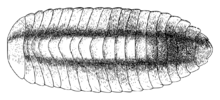Glomeridesmida
| Glomeridesmida | |
|---|---|

| |
| Termitodesmus ceylonicus | |

| |
| Glomeridesmus trinidadensis | |
| Scientific classification | |
| Domain: | Eukaryota |
| Kingdom: | Animalia |
| Phylum: | Arthropoda |
| Subphylum: | Myriapoda |
| Class: | Diplopoda |
| Subclass: | Chilognatha |
| Infraclass: | Pentazonia |
| Superorder: | Limacomorpha Pocock, 1894 |
| Order: | Glomeridesmida Cook, 1895 |
| Families | |
| |
Glomeridesmida is an order of millipedes in the infraclass Pentazonia containing two families (Glomeridesmidae and Termitodesmidae) and at least 35 described species.[1] Glomeridesmida is the only living order of the superorder Limacomorpha.[2][3] Glomeridesmidans are also known as slug millipedes.[4]
Description
[edit]Millipedes in this order are small, usually 4 to 8 mm (0.16 to 0.31 in.) long, with the largest reaching 15 mm (0.59 in) in length.[2] These millipedes are somewhat flattened, and unlike other orders of Pentazonia, are unable to roll into a ball.[5] Glomeridesmidans have antennae with seven segments but are blind and lack ommatidia. The penultimate pair of legs in males are modified into telopods. In most species, females feature a very long ovipositor.[2]
Most adult females in this order have 36 pairs of legs and 21 segments, counting 20 tergites plus the anal shield.[2] Male specimens in this order are rare, unknown for all species in the family Termitodesmidae, and known for only a small number of species in the family Glomeridesmidae.[6] Descriptions of mature males in at least four species (Glomeridesmus spelaeus, G. siamensis, G. arcostriatus, and G. marmoreus) report 35 leg pairs, including a pair of telopods, and 20 segments, one fewer than the 21 segments found in adult females.[6][1][7][8]
Some species, however, seem to deviate from the most common body plan. The description of an adult male of G. indus, for example, reports 37 pairs of legs, including a pair of telopods, and the same 21 segments normally found in adult females.[9] Furthermore, the description of a species from another genus (Glomeridesmoides termitophilus) reports some deviations from the usual pattern, describing females with the usual 21 segments but only 35 leg pairs and two males with the same 21 segments (with 34 and 35 leg pairs, including a pair of telopods).[7] Millipedes in this order develop by hemianamorphosis, with leg and segment number decoupled such that individuals may reach the full complement of one before the other.[10][2]
Habitats
[edit]Millipedes in this order are typically found in soil or ground litter in forests.[3] Two species (Glomeridesmus spelaeus and G. sbordonii), however, are known cave-dwellers and exhibit troglomorphic adaptations such as loss of pigment.[6] The five known species of Termitodesmus (constituting the family Termitodesmidae) are even more unusual in that they are found only in termite mounds.[2] Termitodesmidae is the only myriapod family known to depend on insects in such a commensal relationship.[2][6]
Distribution
[edit]Millipedes in this order are found in tropical regions.[5] The species in the family Glomeridesmidae are found in Middle and South America, India, Southeast Asia, the East Indies and Oceania, whereas those in the family Termitodesmidae are found in India, Sri Lanka, and Vietnam.[2]
References
[edit]- ^ a b Wesener, Thomas; Wongthamwanich, Nattarin; Moritz, Leif (2021-03-16). "Description of the first species of Glomeridesmida from Thailand (Diplopoda, Glomeridesmida, Glomeridesmidae)". ZooKeys (1024): 137–156. doi:10.3897/zookeys.1024.63678. ISSN 1313-2970. PMC 7987703. PMID 33786005.
- ^ a b c d e f g h Enghoff, Henrik; Golovatch, Sergei; Short, Megan; Stoev, Pavel; Wesener, Thomas (2015-01-01). "Diplopoda — taxonomic overview". Treatise on Zoology - Anatomy, Taxonomy, Biology. The Myriapoda, Volume 2: 363–453. doi:10.1163/9789004188273_017. ISBN 9789004188273.
- ^ a b Shelley, Rowland M. (2011). "The Milliped order Glomeridesmida (Diplopoda: Pentazonia: Limacomorpha) in Oceania, the East Indies, and southeastern Asia; first records from Palau, the Philippines, Vanuatu, New Britain, the Island of New Guinea, Cambodia, Thailand, and Borneo and Sulawesi, Indonesia". Insecta Mundi. 196: 1–11.
- ^ "Slug Millipedes (Order Glomeridesmida)". iNaturalist. Retrieved 2024-07-31.
- ^ a b Shelley, Rowland M. (1999). "Centipedes and Millipedes with Emphasis on North American Fauna". The Kansas School Naturalist. 45 (3): 1–16.
- ^ a b c d Iniesta, Luiz Felipe Moretti; Ferreira, Rodrigo Lopes; Wesener, Thomas (2012-11-15). "The first troglobitic Glomeridesmus from Brazil, and a template for a modern taxonomic description of Glomeridesmida (Diplopoda)" (PDF). Zootaxa. 3550 (1): 26–42. doi:10.11646/zootaxa.3550.1.2. ISSN 1175-5334.
- ^ a b Mauriès, Jean-Paul (2019). "Les premiers Glomeridesmida découverts dans le département français de Guyane: nouvelles données sur leur ontogenèse et descriptions de nouveaux taxa: Glomeridesmoides n. g., et trois espèces nouvelles, dont une termitophile (Diplopoda, Glomeridesmida)" (PDF). Bulletin de la Société d'Histoire naturelle de Toulouse (in French). 155: 47–64.
- ^ Mauriès, Jean-Paul (1980). "Diplopodes Chilognathes de la Guadeloupe et ses dépendances". Bulletin du Muséum national d'Histoire naturelle (in French). 4e série 2(A): 1059–1111 – via Biodiversity Heritage Library.
- ^ Carl, J. (1942). "Contribution à la connaissance des Limacomorpha -- Essai de morphologie comparée". Revue suisse de Zoologie (in French). 49: 133–167 – via Biodiversity Heritage Library.
- ^ Enghoff, Henrik; Dohle, Wolfgang; Blower, J. Gordon (1993). "Anamorphosis in Millipedes (Diplopoda) — The Present State of Knowledge with Some Developmental and Phylogenetic Considerations". Zoological Journal of the Linnean Society. 109 (2): 103–234. doi:10.1111/j.1096-3642.1993.tb00305.x.
External links
[edit] Media related to Glomeridesmida at Wikimedia Commons
Media related to Glomeridesmida at Wikimedia Commons Data related to Glomeridesmida at Wikispecies
Data related to Glomeridesmida at Wikispecies- Photographs of Glomeridesmidans
- Discovery of a translucent ancient millipede in a threatened iron-ore cave in Brazil, research from the Museum Koenig.



